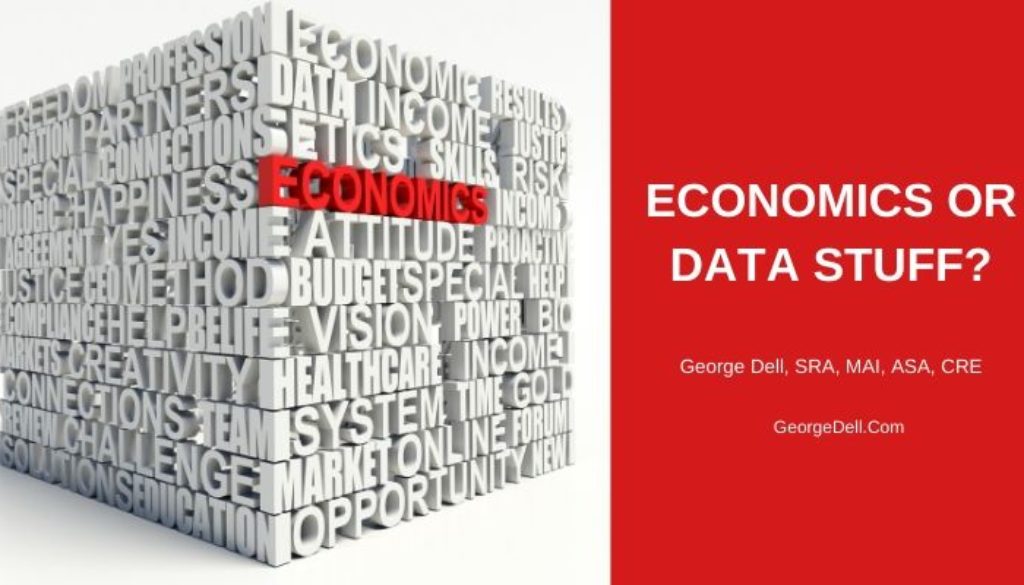Appraisers study some economics. Data training is “pick comps carefully.” AVMs use data. AVMs (Automated Valuation Models) usually use a lot more data, even dozens or hundreds or …. Appraisers usually pick six or seven comps, based on good judgment and training and experience.
We are told comparables should be similar and competitive, so they can be compared. Is this economics, or data sorting?
Economics is a broad field. It comprises macroeconomics and microeconomics. Macro is mostly about national things, including money and banking, government spending and taxing and borrowing and transferring money from one person or corporation to another. Micro is about the firm. How business acts under the profit motive, regulation, and costs and motivation and competition and, sometimes, lack of competition. Economics also deals with international issues, welfare (perceptions of well-being), and local and regional relationships.
Data is data. Nothing much here to talk about until we try to transform data into useful information. There is no need to even look at data unless there is curiosity or a need to make a decision or set a policy about something. (Like appraisal fees.)
Curiosity can be fulfilled by just looking at and finding ways to understand groups of data. Curiosity can be fulfilled in two basic ways: 1) summary numbers – like center (mean, median), like spread (max/min spread, deviation/variance, or quartiles, or; 2) with visuals, like graphs using points (scatterplot), bars (histogram and barplot and boxplot). Humans are quite visual. And we like colors. Graphs are pretty. And useful for the human brain to understand data and even relationships between points and groups.
Decisions can be improved where the data is transformed into relevance! And how is data “transformed”? There are really only two ways data can be converted into useful information. Data can be grouped (or classified). Groups can be binary (yes/no) – like does the hotel have exterior doors or hallway doors. Groups can be multi-categorical, like a garage with 1, 2, 3, or 4 spaces. Data can be associated – like do newer houses in a neighborhood tend to be larger in size. Some associations are just that, associations – they are correlated. Other associations can be calculated via regression. Regression means you have some economic reason or theory which says one variable causes the other.
Is it larger size houses that cause higher prices, or is it higher prices that cause larger houses? It can go either way! If you are a buyer, it is one way. If you are a developer, you calculate the purchasing power (what people can afford/finance) first, which causes you to make decisions about size and other features. Cause can only come from the economic theory, never from the data alone!
Returning to our original description of what is a comparable: similar and competitive.
Competitiveness is an economic concept. Competitiveness constitutes comparability within a market segment. Competitiveness is defined by both supply and by demand. What is available – and what are the desires (welfare, or perceptions of well-being) of potential buyers. Demand and supply.
Because real estate is always unique, there is no true “point” where demand and supply lines cross. There is only a range, or zone of acceptable desirability, and range or selection of availability.
Similarity is a data-to-information concept. (Some call it the science of data.)
Should we separate these two concepts in our head when “picking comps?” Or better yet, should we reduce the problem of similarity from smaller parts of the data, into smaller relevant parts of information, then synthesize (put back together) the parts?
Evidence Based Valuation (EBV)© is a reduced form of the science of data – getting better decisions from better information, from data – which can also be improved. One reason human analysts (valuers) can do better, when necessary, than an AVM. When necessary. AVMs are cheaper and faster.
How can appraisers do better? This is the goal of Valuemetrics.info education and the Community of Asset Analysts©. Join us – toward a better vision of your future.
